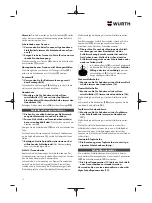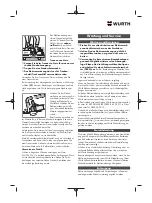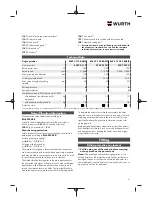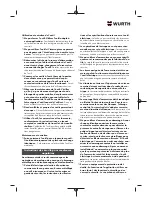
25
The power tool must always
work in an up-grinding mo-
tion. Otherwise, there is a
risk that it will be pushed
un-
controlled
out of the cut.
For best results when cutting
profiles and rectangular
tubing, start at the smallest
cross section.
Cutting stone
r
Provide sufficient dust extraction when cutting
stone.
r
Wear a dust mask.
r
The power tool may be used only for dry cut-
ting/grinding.
For best results when cutting stone, use a diamond cutting disc.
When using the extraction guard for cutting with a cutting
guide
(21)
, the vacuum cleaner must be approved for vacu-
uming stone dust. Suitable dust extractors are available from
Würth.
Switch on the power tool
and position it with the front
part of the cutting guide on
the workpiece. Move the
power tool with a moderate
feed motion that is suited to
the material being ma-
chined.
When cutting especially
hard materials such as con-
crete with a high pebble content, the diamond cutting disc can
overheat and become damaged as a result. This is clearly in-
dicated by circular sparking, rotating with the diamond cutting
disc.
If this happens, stop cutting and allow the diamond cutting
disc to cool down by running the power tool for a short time at
maximum speed with no load.
If work is noticeably slower and with circular sparking, this in-
dicates that the diamond cutting disc has become dull. You
can resharpen the disc by briefly cutting into abrasive material
(e.g. lime-sand brick).
Information on structural design
Slots in load-bearing walls are subject to DIN 1053 part 1 or
country-specific regulations. These regulations must be ob-
served under all circumstances. Seek advice from the respons-
ible structural engineer, architect or construction supervisor be-
fore starting work.
Maintenance and Servicing
Maintenance and cleaning
r
Pull the plug out of the socket before carrying
out any work on the power tool.
r
To ensure safe and efficient operation, always
keep the power tool and the ventilation slots
clean.
r
In extreme conditions, always use a dust ex-
tractor if possible. Blow out ventilation slots fre-
quently and install a residual current device
(RCD) upstream.
When machining metals, conductive
dust can settle inside the power tool, which can affect its
protective insulation.
Store and handle the accessories carefully.
In order to avoid safety hazards, if the power supply cord
needs to be replaced, this must be done by Würth or by a cus-
tomer service centre that is authorised to repair Würth power
tools.
If the power tool should fail despite the care taken in manufac-
turing and testing procedures, repair should be carried out by
Würth MASTERSERVICE staff.
In all correspondence and spare parts orders, please always
include the article number given on the type plate of the
power tool.
The current spare parts list for this power tool can be found on-
line at http://www.wuerth.com/partsmanager or requested
from your nearest Würth branch.
Warranty
For this Würth power tool, we offer warranty in accordance
with legal/country-specific provisions from the date of pur-
chase (verified by invoice or delivery note). Any ensuing dam-
ages are resolved by means of repair or delivery of replace-
ment parts.
Damage that can be attributed to natural wear, overloading
or improper handling is not covered by the warranty.
Claims can only be accepted if the power tool is sent in an un-
dismantled condition to a Würth branch, your Würth sales rep-
resentative or an after-sales service centre for power tools that
has been authorised by Würth.
Disposal
The power tool, accessories and packaging should be re-
cycled in an environmentally friendly manner.
Do not dispose of power tools along with house-
hold waste.
Only for EU countries:
According to the European Directive 2012/19/EU on Waste
Electrical and Electronic Equipment and its implementation into
















































